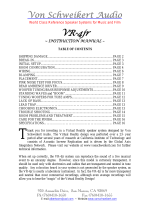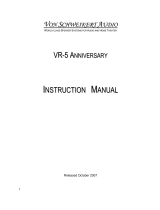Page is loading ...

Magneplanar 1.7i Instruction Manual
Table of Contents
Quick Step-Up Instructions 2
Introduction 3
General Description 3
Carton Contents 3
Packaging 3
Assembly 4
Hookup 4
Caution 4
Speaker Placement 5
Bass Response 5
Left/Right 5
Stereo Width and Imaging 6
Phasing 7
Room Acoustics 8
Optional Tweeter Attenuation 8
Maintenance 8
Specications 9
Revised 2-10-19
Page of 1 9

Quick Step-Up Instructions
Remove the steel magnetic strip from the front of the speakers. If the fabric sticks
to the diaphragm, use a high tack tape to gently pull the fabric loose from the
diaphragm.
The 1.7i has exceptional phase characteristics that are accomplished without the
use of compensation networks. To realize the optimum phasing, the 1.7i should be
angled inward as shown in the diagrams in the manual. (Do not place parallel to
the front wall.) For a larger "sweet spot" and multiple listeners, place tweeters on
the outside. Single listeners may choose to place the tweeters on the inside. If you
do, cant the speakers inward sufficiently so that the tweeter is not ahead of the
bass/midrange in time as shown in the diagrams below . Whether the tweeter is
on the inside or outside, the tweeter should not be closer to the listener than
the bass section. Measuring from your seated position, if the bass panel is 10
feet, 6 inches, the tweeter should be at least 10 feet, 7 inches (think in
distance, not angles).
Tweeter attenuation may be necessary for rooms with hard, reective walls. See
Section 14 below.
Revised 2-10-19
Page of 2 9

Introduction
Congratulations on your purchase. The Magneplanar 1.7i loudspeaker was
conceived and designed by perfectionists, for perfectionists. Due to the elegant
simplicity and ruggedness of the design, the Magneplanar 1.7i loudspeaker will
give many years of trouble-free service.
General Description
The 1.7i is a 3-way, full-range, quasi-ribbon design with a quasi-ribbon bass/
midrange, tweeter, and super-tweeter.
Carton Contents
•1 pair 1.7i loudspeakers
•4 each feet
•4 long bolts in plastic bag for tilt feature and 4 shorter bolts in back of each
speaker
•8 each plastic washers
•2 each 1 ohm resistors
•2 each Magneplanar logos
•1 each Allen wrench
•1 instruction manual
Packaging
Save all packaging. If you need to transport the speakers, they can be shipped
safely only in the original packaging. You may never have to return your
loudspeakers, but should the occasion arise, they should not be shipped in any
packaging but the original. Should you discard it, packaging is available.
Revised 2-10-19
Page of 3 9

Assembly
Before you begin -- Spacers are provided to adjust the vertical angle of the
speakers for a combination of sitting and standing listening positons. Install the
spacers on the bottom mounting bolt to tilt the speaker backwards. The amount
of angle will be dependent on your particular listening conditions. Under most
conditions, stacking 2 spacers will be adequate; however, some experimentation
may be necessary.
•Remove speakers and feet from carton. The 8 mounting bolts are installed in the
speakers.
•We suggest the assistance of a second person will facilitate the installation of
the feet. Place the speaker on its side edge.
•Remove the 8 bolts from the internal T-nuts. Note that one end of the foot is
longer than the other end. Place the longer end toward the front of the speaker.
Carefully align the foot on the backside of the panel so the holes in the foot line
up with the bolts in the panel. Using your ngers, insert a bolt through the
center hole until the bolt engages with the nut in the panel. Do not use a
screwdriver until the bolt has engaged the threads. Care must be taken not to
cross-thread the bolts. Use longer bolts if spacers are used to tilt the speaker.
•Repeat the same procedure for top hole.
•Tighten all the bolts securely.
Hookup
The 1.7i features unique, high current connectors which provide optimum contact
area with the speaker cables up to 10 gauge (or for banana connectors). Simply
strip 1/2" of insulation from the end of the cable. Insert the cable into the terminal
(observing polarity), and tighten the set screws with the Allen wrench provided.
Banana plug connectors can be used and locked in place with the set screws.
Spade lug adapters are available from your Magneplanar dealer for spade
connectors that are incompatible with the Magneplanar high current connector.
Caution
The terminal plate states a maximum fuse value of 4 amps Type 3AG ("normal" or
"fast blow"). The bass section does not require fusing protection. This fuse value
should never be increased or bypassed. Do not use slow-blow fuses. BURNED OUT
TWEETERS ARE NOT COVERED UNDER THE WARRANTY.
Revised 2-10-19
Page of 4 9

Speaker Placement
Proper speaker placement and room acoustics can have a greater effect on a
music system than upgrading one of the components in the system.
Unfortunately, there is no denitive guideline which will cover all possible
listening rooms. Some experimentation is required for locating the optimum
position. The following are a few general guidelines:
Bass Response
Play a CD with repetitive bass. Try the speakers in several possible locations in the
room. Begin experimenting with the speakers about 3 feet from the front wall. Try
moving the speakers forward or backward in increments of 6 to 12 inches. One
position in the room should be noticeably better than others. A lso experiment
with your listening location to avoid standing waves.
Need more bass?
Most of the area of any full-range Maggie is devoted to bass reproduction. (In the
case of the 20.7, 76% of the total radiating area is devoted to bass.) The
Magneplanar Bass Panel offers you the exibility to add bass diaphragm area to t
the needs of your room. From the $600 pair MMG to the 20.7, the Maggie Bass
Panel can get the bass/midbass "just right".
Left/Right
The 1.7i's are matched pairs and mirror-imaged. The serial number for each
speaker in the pair is the same, except for a "1" or "2" following each serial number.
As you face the front of the speakers, the speaker with the serial number ending
with the "1" after its serial number has the tweeter near the left edge, and the
speaker serial number ending with the "2" has the tweeter near the right edge.
Revised 2-10-19
Page of 5 9

Stereo Width and Imaging
Once you have located the best position for the speakers and your chair for bass
performance, separate the speakers by 50-60% of the distance from your chair to
the speakers. For example, if your chair is 10 feet from the speakers, move the
speakers 5-6 feet apart. Now, move the speakers apart in increments of 3 or 4
inches at a time, listening carefully at each position. At some point you will start to
hear two separate speakers instead of a stage effect or continuous image. When
this occurs, your speakers are too far apart. Begin moving the speakers back in
small increments until you notice a point at which you achieve one cohesive
sound stage.
FIG. 1
FIG. 2
Revised 2-10-19
Page of 6 9

Phasing
The Magneplanar 1.7i has superior phase characteristics. We suggest you resist the
tendency to place the speakers so they are parallel to the front wall. For optimum
phasing, the speakers should angled as shown in Figures 1 or 2.
Depending upon the acoustics of your room, the imaging and sound stage may
be better with the tweeters on the inside for listening only in the "sweet spot". For
a larger audience and listening further off-axis, try tweeters on the outside. Angle
the speakers as shown in Figures 1 or 2.
Once you have located the ideal speaker position, a mark is helpful for quickly
replacing the speakers. A small tack, yarn woven into the carpet, or piece of tape
can be placed on the carpet so your ideal listening spot can be easily relocated
when the speakers (or chair) are moved for cleaning, etc. In the event your ideal
listening spot is inconvenient from the standpoint of the room layout and decor,
simply slide the speakers wherever they look best. For background listening the
speakers can be placed close to the wall and it will make little difference.
Revised 2-10-19
Page of 7 9

Room Acoustics
The judicious use of damping material can improve the sound. Acoustical
damping can be achieved with household items or wall hangings. A word of
caution--when audiophiles discover the effectiveness of damping material, they
sometimes overdo it (on the premise that if a little is good, more is better). Before
making a permanent change to your room, experiment with the positioning of
the damping material. Usually a portion of one or two parallel walls should have
some damping. However, it is a trial-and-error process.
An over-damped room will provide very precise imaging, but the sound will seem
"dead." An under-damped room may heighten the illusion of being in a concert
hall, but the imaging will seem imprecise with all the instruments mixed together.
"Hardness" or over-bright sound is usually the result of a room with hard surfaces
(glass, hard paneling,etc.). Moderation is the key.
Diffusers are also helpful to improve the acoustics of a room. Contact your
Magnepan dealer for more information on the proper use of diffusers.
Optional Tweeter Attenuation
There are two principal reasons for needing to attenuate the Magneplanar Quasi-
Ribbon Tweeter and Super Tweeter:
•Pop or rock recordings often exhibit a pronounced rise in the treble
region.
•The Magneplanar Quasi Ribbon Tweeter is very efficient in its total
energy dispersion. If the surrounding walls are exceptionally reflective,
the overall perceived acoustical balance will be tipped towards a "hot"
high end.
Attenuation is performed through insertion of a resistor in place of the jumper.
The pair of 1.2 ohm resistors will attenuate the tweeter 1-2 dB. Other values are
available from your Magneplanar dealer.
Maintenance
Light vacuuming of the grille cloth is possible.
Revised 2-10-19
Page of 8 9

Specications
* Because there are no universally accepted methods for loudspeaker
measurements, frequency response specications may be stated by most
manufacturers without reference to measurement techniques and/or specic
locations in rooms. Magneplanar loudspeaker frequency response specications
are average performance levels that may reasonably be expected in normal
installations.
System Description
3-Way, full-range, quasi-ribbon speaker.
Frequency Response
40Hz--22kHz" +/- 3dB
Sensitivity
86 dB, 500Hz, 1 meter, 2.83V
Impedance
Nominal 4 Ohms
Dimensions
19-1/4" X 64-1/2" X 2"
Warranty
LIMITED. 3 Years to Original Owner
Shipping Weight
95 lbs.
Revised 2-10-19
Page of 9 9
/







